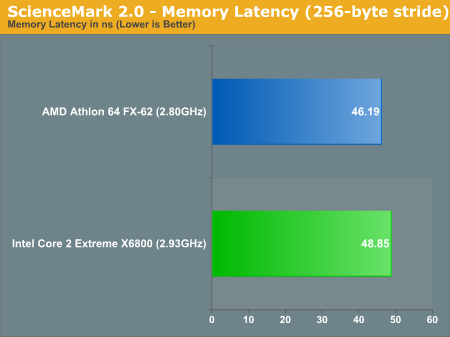Intel Core 2 Extreme X6800 Preview from Taiwan
by Anand Lal Shimpi & Gary Key on June 6, 2006 7:35 PM EST- Posted in
- CPUs
Memory Latency and Bandwidth
We've never been able to look at some of the low level characteristics of Intel's Core architecture, and although we didn't have enough time to do a thorough run of low level benchmarks we were able to run ScienceMark 2.0 in order to get an idea of how the Core 2 Extreme stacked up against the FX-62 in terms of memory latency and bandwidth.
We had seen Conroe performance results that showed the new architecture being able to offer fairly competitive memory access latencies to AMD's architecture, without the need of an on-die memory controller. Our ScienceMark 2.0 results confirm just that:
While AMD still offers lower memory latency, the Core 2 Extreme X6800 is very close in comparison - especially considering that it has no on-die memory controller. With lower clock speeds than its Pentium D siblings and a faster FSB, memory access latency is reduced tremendously with Conroe. On a larger scale, through a very effective cache subsystem as well as memory disambiguation, Conroe can offer significantly improved memory performance compared to its predecessors, including the Athlon 64 X2/FX.

ScienceMark's memory bandwidth results offer a very telling story, showing us the bandwidth limitations of Intel's FSB architecture. While the FX-62's peak theoretical bandwidth is not achieved in real world, you can see how AMD's Direct Connect architecture offers higher limits for chip-to-chip communication.











134 Comments
View All Comments
munky - Tuesday, June 6, 2006 - link
Good work on running some benches on a system not built by Intel. Conroe puts out impressive numbers, it may just live up to the hype when launched.xFlankerx - Tuesday, June 6, 2006 - link
Perfectly in line with older performance figures. Conroe's looking like a surefire winner.PCSJEFF - Wednesday, June 28, 2006 - link
If you wanna test the CPU in games, why don't you use Grand Prix 4 and Everquest 2: those two games 3D engines use a lot more the CPU than the video card.Supa - Tuesday, June 6, 2006 - link
In the original benchmark, if you still remember, the 20% performance advantage was achieved by E6700 (2.67) over 2.8 AMD.Now the new 20% advantage was achieved by X6800 (2.93) over 2.8 AMD.
Not quite the same 20%.
If anything, the tightening of memory latency (5-5-5-12 in this test) can only benefit AMD a bit more.
---
Gary Key - Thursday, June 8, 2006 - link
It benefits the Intel based system just as much. ;-)
IntelUser2000 - Tuesday, June 6, 2006 - link
Original benchmark: Using Crossfire X1900XTX to alleviate bottlenecks
Now: Single Geforce 7900GTX
If you see FEAR benchmarks you'll see it'll be better in real world gaming as there is bigger advantage in minimum frame rates. At IDF system there is bigger difference in max frame rates.
Carfax - Tuesday, June 6, 2006 - link
Wow, the Core 2 is obviously bottlenecked by the single 7900 GTX O_O!!!Who'd have thought this would happen a few months ago?
peternelson - Wednesday, June 7, 2006 - link
Good point, when hardware permits, redo the test with TWO gpus in there and see if the same lead is evident.
IntelUser2000 - Tuesday, June 6, 2006 - link
The tightening of memory will benefit Core too.peternelson - Tuesday, June 6, 2006 - link
And based on these performance figures,
a 4x4 board with TWO FX62 will vastly outperform a lonely Intel Conroe.
And for heavy I/O ie beating network and disk to death, Intel has not been shown to have the performance headroom. AMD I/O will scale nicely.
When Intel counter with quadcore, they will find their FSB even more limiting, at which point the wisdom of the Hypertransport approach will be evident.
Depends how quickly 4x4 comes to market (but said to be 2H2006)